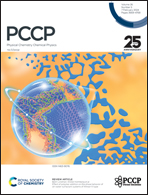Theoretical study on electrocatalytic carbon dioxide reduction over copper with copper-based layered double hydroxides†
Abstract
The conversion of CO2 into valuable fuels and multi-carbon chemical substances by electrical energy is an effective strategy to solve environmental problems by using renewable energy sources. In this work, the density functional theory (DFT) method is used to reveal the electrocatalytic mechanism of CO2 reduction reaction (CO2RR) over the surface of CuAl-Cl-layered double hydroxides (LDHs) with Cu monoatoms (Cu@CuAl-Cl-LDH), Cu2 diatoms (Cu2@CuAl-Cl-LDH), orthotetrahedral Cu4 clusters (Td-Cu4@CuAl-Cl-LDH) and planar Cu4 clusters (Pl-Cu4@CuAl-Cl-LDH). The active sites, density of states, adsorption energy, charge density difference and free energy are calculated. The results show that CO2RR over all the above five catalysts can generate C2 products. Pl-Cu4@CuAl-Cl-LDH tends to generate C2H5OH, while the remaining four structures all tend to produce C2H4. Cuδ+ favors CO2RR, and Td-Cu4@CuAl-Cl-LDH with a larger positively charged area at the active site has the better electrocatalytic performance among the calculated systems with a maximum step height of 0.78 eV. The selectivity of the products C2H4 and C2H5OH depends on the dehydration of the intermediate *C2H2O to *C2H3O or *CCH; if the dehydration produces *CCH intermediate, the final product is C2H4, and if no dehydration occurs, C2H5OH is produced. This work provides theoretical information and guidance for further rational design of efficient CO2RR catalysts for energy saving and emission reduction.



 Please wait while we load your content...
Please wait while we load your content...